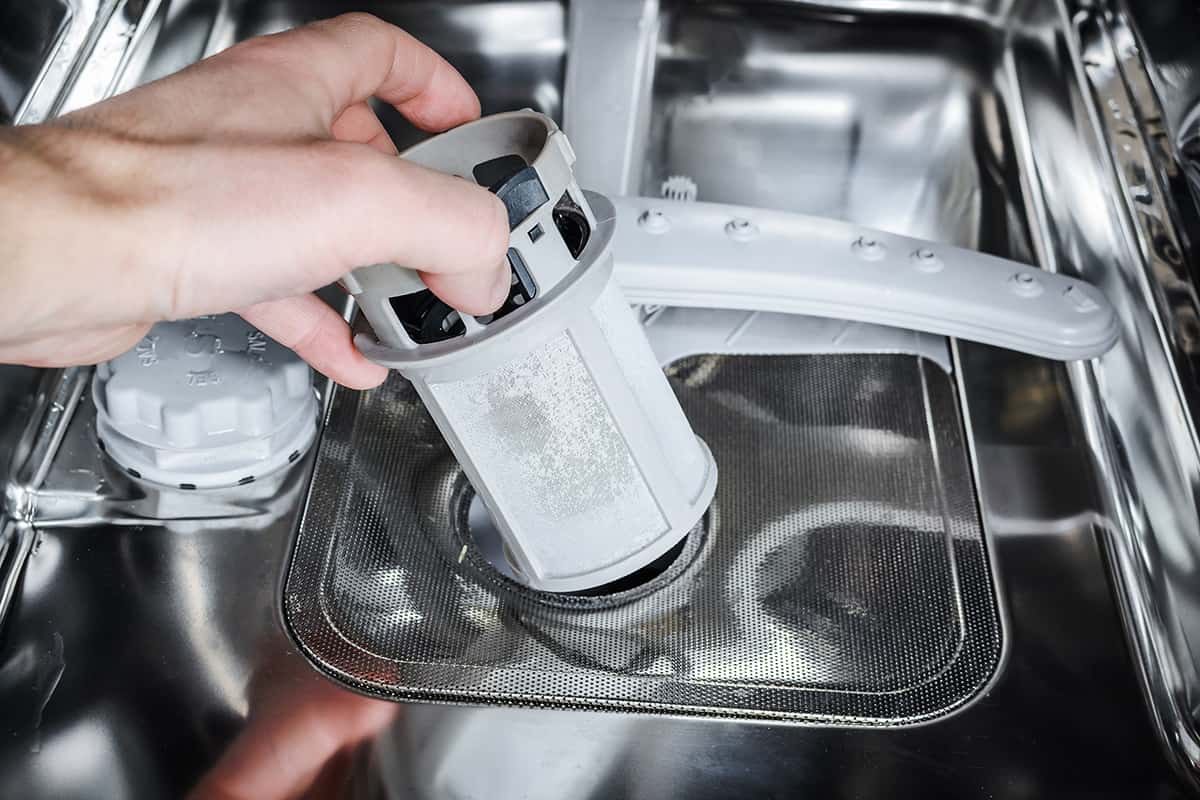Dishwasher maintenance isn’t just about cleaning your dishwasher; it’s also about keeping your dishwasher in tip-top shape. Since you use your dishwasher almost every day, you should come up with a maintenance checklist.
Use the following checklist to make sure your dishwasher is working at its best:
- Check the spraying arms
- Clean the inside edges
- Empty the filter assembly
- Unclog the drain
- Inspect the gasket
- Check the door-locking mechanism
In this guide, I’ll explain in more detail how to perform a maintenance check on your dishwasher, as well as provide a few pointers on how to keep your dishwasher working optimally.
Dishwasher Maintenance Checklist
Even though a dishwasher can relieve you of the physical labor of handwashing dishes sanitizing your dishes, it still requires your assistance to do its job properly. Here’s what you need to remember before running your dishwasher.
1. Check the spraying arms
The way a dishwasher works is that pressurized water comes shooting out of the spraying arms. These arms are usually located underneath or above the top and bottom dishracks. In order to clean every square inch of your dishes, they need to spin freely on their hinges.
To check the spraying arms, rotate the arms until you can see the tiny holes on the side. The water comes shooting out of those tiny holes. If there’s a blockage in any of the holes, you will need to poke them out of the way with a bamboo skewer, a toothpick, or a straightened paperclip.
2. Clean the inside edges
If your dishwasher has a lingering nose-wrinkling scent, there’s a good chance that it’s not clean. That’s right—your dishwasher, while it does an impressive job of washing dishes, doesn’t exactly rid itself of dirt, debris, and bacteria.
Inspect the inner edges of the dishwasher’s tub and keep an eye out for dark spots or discoloration. If you find mold, mildew, or old debris, you will need to scrub it away by mixing a 1:4 parts mix of vinegar and water. Use a soft brush to scrub the spot away until it’s completely gone.
After cleaning the tub and the inner edges, run a quick rinse cycle. Now, open the dishwasher and inhale. If you cleaned it properly, it shouldn’t smell like anything.
3. Empty the filter assembly

Not many new dishwasher owners know this, but the filter assembly needs to be emptied periodically. If you don’t, there will be a terrible smell whenever you open the dishwasher door.
To access the filter assembly, pull out the bottom dishrack as far as it will go, and look for a mesh trap located above the drain port.
Carefully remove the filter assembly and toss away the collected debris. Now, separate the filter assembly parts, dunk them in a basin of soapy water, and scrub them with the soft side of a sponge or a soft brush. Rinse the parts, put them back together, and reinstall them in the dishwasher.
4. Unclog the drain
Dirty water and microscopic food particles will slip into the drain, where they will eventually exit your home via the sewer line. If there’s standing water in your dishwasher, or if can smell something foul after cleaning the inside of the unit, there’s a good chance the drain is clogged.
Before reinstalling the dishwasher, inspect the drain port for blockages. You will need to use a straightened wire hanger or a snaking attachment to break down and remove solid debris hidden inside the drain port.
After cleaning the drain, try pouring a bucket of water into the dishwasher. The water should immediately begin draining down the line.
5. Inspect the gasket
The gasket is the rubber or silicone found on the inner edge of the dishwasher door or the outer perimeter of the dishwasher’s front panel. It creates an airtight seal whenever you shut the door to prevent water from leaking out.
Open the dishwasher door and run a finger along the gasket’s surface. Watch for cracks or tears in the gasket, which can let droplets of water escape during the dishwasher filling phases. If there’s noticeable damage to the gasket, you may need to replace it entirely.
6. Check the door locking mechanism

The locking mechanism is made up of tiny components found on the dishwasher door. If it works as intended, your dishwasher should lock in place whenever you turn the dishwasher on. A damaged locking mechanism may prevent your dishwasher from turning on or cause the dishwasher door to move when running a wash cycle.
Open the dishwasher door and inspect the locking mechanism. Use a toothpick to carefully remove debris, making sure not to interfere with the microswitch. Test the door to make sure it locks into place by activating a wash cycle and trying to pull the door open. If the locking mechanism is damaged, you may need to replace it entirely.
Additional Dishwasher Maintenance Tips
The previous checklist describes what you should check for whenever you want to run your dishwasher. Here, I’ll provide you with a few pointers on what you can do to keep your dishwasher at its best.
1. Run the dishwasher at least 5 times a week
It may sound excessive if you live alone, but this is necessary if you don’t want the dishwasher to break down over time. Like any household appliance, dishwashers work best when they’re used regularly. In addition, the water will keep the gasket and every other part lubricated, preventing creaking and accelerated wear.
2. Check the dish rack’s plastic coating for damage
Many dishwashers come with plastic-coated dish racks. The plastic protects the inner metal from rusting due to excessive exposure to water and chemicals. When rust forms, it’s virtually impossible to get rid of, and the rust will break off and contaminate your dishes. If the plastic coating is damaged in any way, you should replace the dish rack entirely.
3. Use dishwasher salt to soften hard water

Hard water is water with high mineral concentrations. It can lead to limescale buildup, which can affect your dishwasher’s look and functionality. If you only have access to hard water at home, you will need to maintain your home’s water softener. On top of that, you can prevent hard water from impacting your dishwasher by using dishwasher salt.
4. Only use dishwasher-safe products in your dishwasher
This may sound like a no-brainer, but you’d be surprised by how many people make the mistake of putting plastic and cast-iron skillets in their dishwashers. That’s not to say all plastics aren’t dishwasher-safe, but you should look for a label on the product’s packaging for certainty.
5. Check the water temperature
Dishwashers typically heat water to between 120 and 140°F, with some models going as high as 150°F for sanitizing cycles. Open your dishwasher’s manual and look for the water temperature ratings. If your dishwasher doesn’t heat the water to within 5°F of the noted temperature, you should inspect the heating element or alter the temperature setting of your home’s water heater.
6. Reset the dishwasher every 6 months
Resetting a dishwasher is sort of like a mild factory reset. This is necessary if your dishwasher was in the middle of a wash cycle during a power outage or if it’s exhibiting signs of wear (slower refilling times, stuck on a cycle, etc.).
Open the dishwasher manual to figure out how to perform a reset. Alternatively, you can cut the power to the machine by unplugging it or killing the circuit switch. Let it rest for 1 to 2 minutes before turning the power back on.






